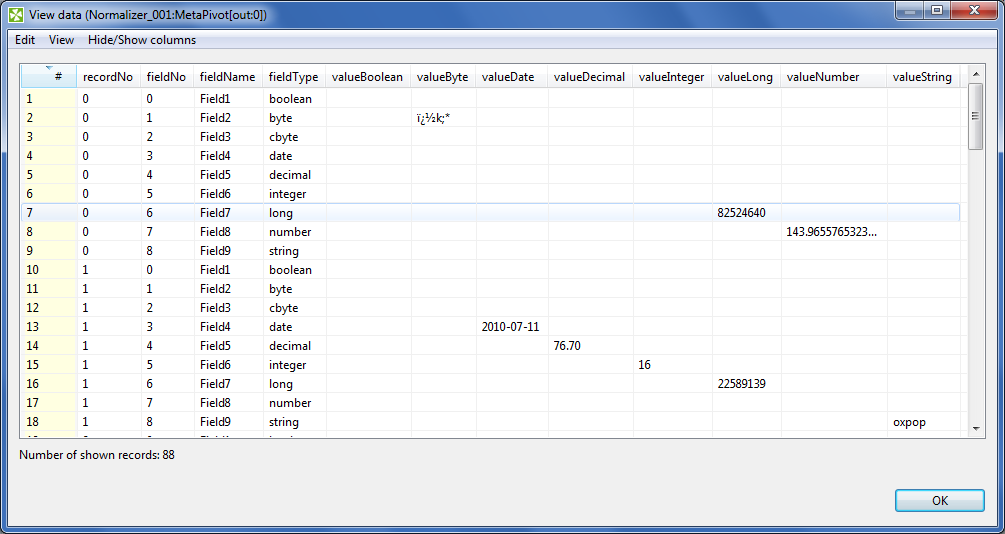MetaPivot

We suppose that you have already learned what is described in:
If you want to find the appropriate Transformer for your purpose, see Transformers Comparison.
Short Summary
MetaPivot converts every incoming record into several output records, each one representing a single field from the input.
| Component | Same input metadata | Sorted inputs | Inputs | Outputs | Java | CTL |
|---|---|---|---|---|---|---|
| MetaPivot | - | no | 1 | 1 | no | no |
Abstract
On its single input port, MetaPivot receives data that do not have to be sorted. Each field of the input record is written as a new line on the output. The metadata represent data types and are restricted to a fixed format, see Advanced Description All in all, MetaPivot can be used to effectively transform your records to a neat data-dependent structure.
Unlike Normalizer, which MetaPivot is derived from, no transofmation is defined. MetaPivot always does the same tranformation: it takes the input records and "rotates them" thus turning input columns to output rows.
Icon

Ports
| Port type | Number | Required | Description | Metadata |
|---|---|---|---|---|
| Input | 0 | yes | For input data records | Any1 |
| Output | 0 | yes | For transformed data records | Any2 |
MetaPivot Attributes
MetaPivot has no component-specific attributes.
Advanced Description
When working with MetaPivot, you have to use a fixed format of the output
metadata. The metadata fields represent particular data types. Field names
and data types have to be
set exactly as follows (otherwise unexpected
BadDataFormatException will occur):
[recordNo long] - the serial number of a record
(outputs can be later grouped by this) - fields of the same record
share the same number (notice in Figure 55.3, Example MetaPivot Output )
[fieldNo integer] - the current field number: 0...n-1 where
n is the number of fields in the input metadata
[fieldName string] - name of the field as it appeared
on the input
[fieldType string] - the field type, e.g. "string",
"date", "decimal"
[valueBoolean boolean] - the boolean value of the field
[valueByte byte] - the byte value of the field
[valueDate date] - the date value of the field
[valueDecimal decimal] - the decimal value of the field
[valueInteger integer] - the integer value of the field
[valueLong long] - the long value of the field
[valueNumber number] - the number value of the field
[valueString string] - the string value of the field
The total number of output records produced by MetaPivot equals to (number of input records) * (number of input fields).
You may have noticed some of the fields only make the output look better
arranged. That is true - if you needed to omit
them for whatever reasons, you can do it. The only three fields that
do not have to be included in the output metadata are: recordNo,
fieldNo and fieldType.
Example 55.4. Example MetaPivot Transformation
Let us now look at what MetaPivot makes with your data. Say you have an input file containg data of various types separated into fields. You have only two records:
Sending these data to MetaPivot "classifies" the data
to output fields corresponding to their data types:
Thus e.g. "myString" is placed in the valueString field
or "76.70" in the valueDecimal.
Since there were 2 records and 9 fields on the input, we have got 18 records
on the output.

